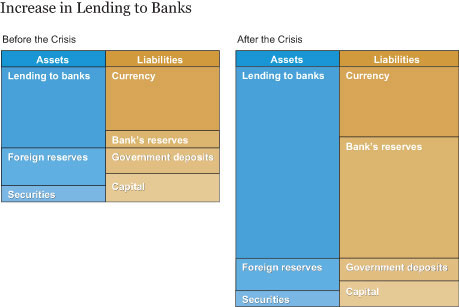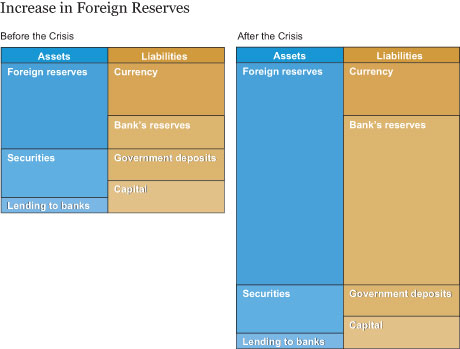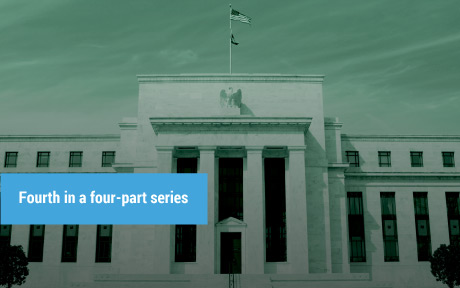The 2007-09 financial crisis, and the monetary policy response to it, have greatly increased the size of central bank balance sheets around the world. These changes were not always well understood and some were controversial. We discuss these crisis-induced changes, following yesterday’s post on the composition of central bank balance sheets in normal times, and explain the policy intentions behind some of them.
Liabilities Composition during the Crisis
The primary change on the liability side of central banks’ balance sheets was a large build-up of reserves available to the banking system. This happened in two phases. First, during the crisis itself, many central banks around the world were active in supplying liquidity to shaky financial systems. Second, post crisis, several central banks began pursuing unprecedented quantitative easing (QE) policies by purchasing large quantities of certain types of assets from the private sector to boost their struggling economies. The increase in reserves was, in many cases, a by-product of the policies these central banks were pursuing, as we explain below.
During the crisis, central banks typically extended loans to banks, and sometimes less traditional counterparties, to support financial stability. These loans provided much needed liquidity to banks and other financial intermediaries and increased the amount of reserves. For example, in the United States, during 2008, reserves increased from $13 billion to almost $850 billion.
To some extent, this increase was necessary to accommodate an increase in demand, as banks wanted to hold more liquid assets to protect themselves from shocks. In many cases, however, the measures to support financial stability led to an increase in the amount of reserves so large that it far outstripped the increased demand by banks. Hence, without further central bank interventions, reserves may not have been sufficiently scarce to conduct monetary policy in “corridor” systems (see our first post “Standard Elements of a Monetary Policy Implementation Framework”). Many central banks took measures to limit the increase in reserves. For instance, the Federal Reserve sold securities. Other central banks such as the Norges Bank, the Reserve Bank of Australia, the Swiss National Bank (SNB), and the Bank of England (BoE) used term deposits, repos, or the issuance of bills to limit the increase in reserves due to increased lending.
After the crisis, some central banks conducted QE policies to stimulate their economy, for example, by lowering long-term interest rates. The intention was not necessarily to increase the supply of reserves. Nevertheless, asset purchases increase reserves substantially, all else the same, and thus bear on monetary policy implementation. For example, the Fed increased reserves in the banking system by about $2 trillion between 2008 and 2014, mainly due to its large-scale asset purchase (LSAP) program. Similarly, the BoE has increased the supply of reserves sevenfold since January 2009, again mostly due to its Asset Purchase Facility. These large increases mean that these central banks cannot rely on scarcity to increase their interest rate target because banks are awash with reserves. Instead, they have to rely on arbitrage, as discussed in our first post, at least until they reduce the supply of reserves.
Asset Composition during the Crisis
The changes in central banks assets also differed substantially between the crisis and its aftermath. During the crisis, central banks increased their lending to counterparties so as to increase liquidity and available funding. The effect is illustrated below as an increase in lending to banks matched by an increase in reserves. But, as discussed above, the increase in lending was in some case matched by increases in government deposits or other liabilities.

Most central banks increased their lending to banks, and sometimes to nonbanks, during the 2007-09 financial crisis. Because of the exigent circumstances, many were willing to lend for longer terms and against a wider set of collateral than normally, thereby increasing their risk exposure. This International Monetary Fund working paper discusses the risk created by the changed collateral framework in detail.
Some central banks also purchased assets during the crisis, for example, to prevent fire sales from occurring in key markets. Early in the crisis, the Fed purchased commercial paper and some impaired assets of distressed intermediaries Bear Stearns and AIG. These assets have largely been sold or have matured.
After the crisis, several central banks turned to quantitative easing to stimulate their economies because their policy interest rate could not be lowered much more. Asset purchases can stimulate the economy by reducing credit and liquidity risk premiums or term premiums, or by lowering exchange rates.
An advantage of central bank asset purchases is that assets can be purchased from “nontraditional” counterparties that are not eligible to borrow from the central bank, which expands the central bank’s reach. In normal times, arbitrage will lead to effective redistribution of liquidity and risk in markets, but in crisis, this may no longer be the case, and reaching financial institutions outside the central bank’s normal counterparties may therefore be useful. Further discussion of how asset purchases affect financial markets can be found in this paper in the New York Fed’s Economic Policy Review series.
What They Purchased
The majority of assets purchased under these programs were government bonds. The Bank of Japan, for one, has purchased government bonds almost exclusively, although it has small portfolios of other assets (commercial paper, corporate bonds, and exchange-traded funds.) The Riksbank has only purchased government bonds.
By contrast, the Fed has purchased mortgaged-backed securities and the ECB has purchased asset-backed securities and covered bonds along with government bonds and others assets. The SNB has focused on large-scale purchases of foreign currency, which represented over 90 percent of its assets at the end of 2015.

In the cases above, the central banks’ assets purchases show up directly on their balance sheets. The BoE did things differently; its purchases show up only indirectly on the balance sheet as a loan to the Asset Purchase Facility (APF), a subsidiary of the BoE that actually bought the assets. The APF, established in 2009, initially held commercial paper and corporate bonds, but now holds only government bonds (gilts). Furthermore, any risk or actual losses arising from the APF are borne by the U.K. Treasury, rather than the BoE.
Finally, a number of central banks, such as the Federal Reserve, the BoE, and the Norges Bank, provided liquidity via swaps of liquid assets for illiquid ones during the crisis. These central banks swapped government securities for less-liquid securities such as covered bonds, mortgage-backed securities, asset-backed securities, and corporate bonds. These arrangements can reduce liquidity spreads for less-liquid assets by guaranteeing that the asset can be traded for a fully liquid asset, extend funding to the institutions that hold the assets, and provide liquidity to institutions that are not eligible to borrow at the central bank.
In some cases, the swaps were conducted over the treasury’s balance sheet instead of the central bank’s, so that the treasury bore the associated risk. For further discussion of how asset swaps affect financial markets, see this BoE paper.
Summary
The dominant change in central bank balance sheets amidst the crisis was due to dramatically increased lending to banks, but asset purchases and asset swaps led to important changes in terms of nontraditional asset holdings, besides loans to banks. These changes greatly expanded central bank balance sheets and dramatically increased the stock of reserves, a component of money supply. Finally, both swaps and asset purchases may be held on the treasury’s balance sheet instead of the central bank’s, thus exposing the former to any attendant risks.
Disclaimer
The views expressed in this post are those of the authors and do not necessarily reflect the position of the Federal Reserve Bank of New York or the Federal Reserve System. Any errors or omissions are the responsibility of the authors.

Emily Eisner is a senior research analyst in the Federal Reserve Bank of New York’s Research and Statistics Group.

Antoine Martin is a senior vice president in the Bank’s Research and Statistics Group.
Ylva Søvik is a deputy director at Norges Bank, the central bank of Norway.











 RSS Feed
RSS Feed Follow Liberty Street Economics
Follow Liberty Street Economics